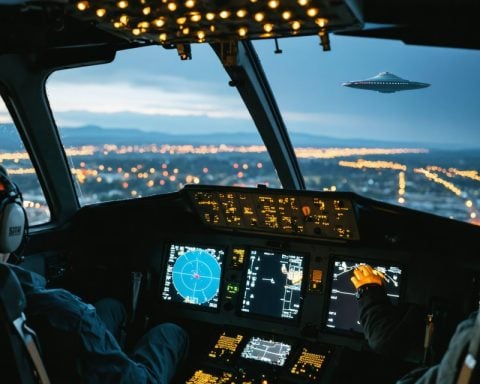- The American drone industry is experiencing growth and increased independence from Chinese components due to national security and technological concerns.
- Sanctions on Chinese suppliers like T-Motor by U.S. authorities highlight vulnerabilities in the supply chain and emphasize the need for alternative sources.
- State-led initiatives, such as those in North Dakota and Florida, aim to reduce reliance on Chinese technology and promote domestic manufacturing.
- American companies like BRINC Drones and Skydio are emerging as leaders in the industry, setting the stage for innovation and expanded drone functionality.
- A potential ban on DJI, a major Chinese drone manufacturer, could provide opportunities for U.S. drone companies to capture market share.
- Drones are increasingly vital to public safety agencies, revolutionizing areas like surveillance and disaster response with advanced domestic technology.
- The evolving drone landscape offers American manufacturers a chance to enhance community safety through resilience and innovation.
Amidst sprawling skies and boundless possibilities, the American drone industry is surging, transforming the landscape of tech manufacturing. This renaissance marks a departure from reliance on Chinese components, driven by potent forces of national security and technological independence.
Recent sanctions imposed by the U.S. Department of Treasury’s Office of Foreign Assets Control on Jiangzi Xintuo Enterprise Co. Ltd—known globally as T-Motor—underscore rising concerns about supply chain vulnerabilities. These sanctions, coupled with previous classifications by the Department of Commerce, disrupt a significant artery of drone manufacturing and highlight an urgent need for alternative suppliers.
Across the nation, states are spearheading initiatives to sever ties with Chinese drones. North Dakota, for instance, is embarking on a $15 million venture to purge its agencies of Chinese technology. Florida follows suit, adhering to stringent purchasing guidelines. Not solely an American phenomenon, Ukraine too is showcasing its own drone manufactures as it pivots away from Chinese dominance.
Amid this shifting terrain, American innovators like BRINC Drones and Skydio are poised to seize command. These manufacturers stand at the forefront, promising advancements that could redefine drone utility. As fears mount over Chinese technology, a potential DJI ban looms large, ready to carve a new niche for U.S. companies.
Public safety agencies, often the lifelines of communities, stand to gain immensely from this tectonic shift. With drones revolutionizing surveillance, disaster response, and tactical support, agencies might soon find themselves equipped with more adept, domestically produced tools.
A dynamic industry intertwines with critical security needs, presenting unique opportunities for American manufacturers. As they rise to the occasion, the ultimate legacy rests in enhanced public safety and empowered communities—an embodiment of resilience and innovation.
Will the American Drone Industry Dominate in a Post-Chinese Era?
Introduction
The American drone industry is undergoing a significant transformation fueled by national security concerns and the push for technological independence. The recent sanctions on major Chinese drone component suppliers, such as Jiangzi Xintuo Enterprise Co. Ltd (T-Motor), by the U.S. government underscore the importance of these shifts. This article delves into various aspects of the American drone industry’s evolution, including market trends, emerging opportunities, and practical recommendations for stakeholders.
How-To Steps & Life Hacks: Building a Drone Business
1. Understand Regulations: Familiarize yourself with Federal Aviation Administration (FAA) requirements and any state-specific drone laws.
2. Identify a Niche: Focus on specialized market segments such as agricultural drones, delivery services, or public safety applications.
3. Source Components Domestically: Leverage American suppliers to mitigate supply chain risks.
4. Invest in R&D: Innovation is key to staying competitive. Consider partnering with universities or technology incubators.
5. Implement Sustainability Practices: Use eco-friendly materials and design energy-efficient drones to appeal to environmentally conscious clients.
Real-World Use Cases
– Public Safety: Law enforcement agencies use drones for crime scene analysis and traffic management.
– Disaster Response: Drones offer real-time data and imagery in natural disasters, aiding quicker response times.
– Agriculture: Farmers employ drones for crop monitoring and precision agriculture, optimizing resources and boosting yields.
Market Forecasts & Industry Trends
The U.S. drone market is projected to grow significantly. According to a report by Markets and Markets, the drone services market is expected to reach $63.6 billion by 2025, growing at a CAGR of 55.9% from 2020 to 2025. This growth is bolstered by increased demand for advanced drone applications in commercial industries and national defense.
Reviews & Comparisons: American vs. Chinese Drones
– BRINC Drones vs. DJI: BRINC offers advanced features tailored for public safety, such as two-way communication capabilities and robust design for harsh environments. DJI, although a market leader, faces security and privacy scrutiny.
– Skydio vs. Autel Robotics: Skydio provides superior autonomous navigation powered by AI, ideal for complex environments, whereas Autel is known for its high-quality imaging technology.
Controversies & Limitations
– Privacy Concerns: Increased drone use has sparked debates on surveillance and data collection.
– Technology Transfer Issues: The need to innovate while protecting intellectual property remains a challenge.
– Regulatory Hurdles: Navigating the evolving regulatory landscape can be complex and time-consuming.
Features, Specs & Pricing
– BRINC Drones: Features real-time video streaming, modular design; pricing varies based on customization.
– Skydio: Autonomous flying capabilities, 4K camera resolution; prices start from around $999.
Security & Sustainability
American drone manufacturers are emphasizing cybersecurity measures to protect against data breaches. Additionally, there is a growing focus on sustainable production practices, with companies trying to reduce their carbon footprint through more efficient manufacturing processes.
Insights & Predictions
With ongoing geopolitical tensions and increasing investment in domestic capabilities, the U.S. drone industry is poised for significant expansion. Companies capable of rapid innovation and adaptation to regulatory changes will likely emerge as industry leaders.
Actionable Recommendations
– Explore Local Collaborations: Engage with domestic suppliers to enhance supply chain reliability.
– Invest in Workforce Development: Train employees on the latest drone technologies and regulations.
– Focus on Next-Gen Technology: Embrace AI and machine learning to develop more autonomous and capable drones.
For more updates and resources, visit the official Federal Aviation Administration website.
By understanding these dynamics, businesses and stakeholders can position themselves advantageously in the rapidly evolving American drone landscape.



















